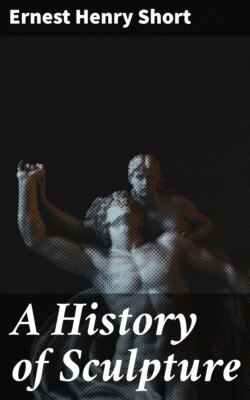Читать книгу A History of Sculpture - Ernest Henry Short - Страница 11
На сайте Литреса книга снята с продажи.
CHAPTER II
ОглавлениеTable of Contents
THE PARTHENON AND THE TEMPLE STATUARY OF GREECE
(470 b.c. TO 420 b.c.)
On the vast canvas of recorded history one half-century has always stood out. The clearer the vision of the observer and the larger his view, the more every line in the composition has appeared to converge upon and lead up to that central point. Ever and again the imagination of man, fascinated by some new beauty, has been tempted away. It has always returned with a new wonder. The advance of knowledge has changed the world’s estimate of this and that part of the glowing record of human action and endeavour. But the relative importance of those fifty years has been preserved throughout the ages.
This, we believe, represents the true position of Athens during the fifth century before our era in the scheme of general history. But a great art is only the expression of a nation’s moods. As the Greek epigram puts it:
“I sang those songs that gain so much renown: I, Phœbus; Homer merely wrote them down.”
We have therefore only to alter a few phrases to arrive at the real position of Athenian sculpture between 470 and 420 b.c. in the scale of artistic achievement. The proposition may need qualification. If so, we may well prepare ourselves for the task by the most generous appreciation of this—the Golden Age of Sculpture.
So much for panegyric. What are the facts? How closely was sculpture connected with the every-day and all-day lives of the Athenian citizens? We shall find that the art was interwoven with all that was most vital in the nation’s history; that its roots struck down deep into the hearts of the people.
The victory at Marathon, which broke the spell of Persian invincibility, and the brilliant sea fight at Salamis, which settled the future course of civilisation in Western Europe, had made Athens the principal city in Greece. The smaller states in her vicinity and the great trading cities of Asia Minor, attracted by the position of Athens as a sea power, joined the Confederation of which she was the leading spirit. Even those which refrained from a political alliance could not withhold their admiration from the men who had done so much to save Greece from the dreaded hordes from the East.
The Athenians had, however, only attained this position at the cost of the destruction of their city. Xerxes had sacked and burnt Athens during the second campaign of 480 b.c. Directly peace was assured the Athenians set to work to rebuild the town. Cimon, the aristocrat, and Pericles, the democrat, vied with each other in ensuring that the new city should outshine the capital of any state in Greece. With fresh markets opening up every year the material prosperity of Attica increased by leaps and bounds. Produce poured in from Asia Minor, the islands of the Ægean, the colonies in Sicily and Italy, and the settlements on the shores of the Black Sea. Directly the absolutely necessary rebuilding had been accomplished and the defences of the town were sufficiently sure, the Athenians prepared to make their city worthy of the headship of the Panhellenic League. In bringing this about they were to do honour to the goddess to whose fostering care they ascribed their victory over the great conqueror of the East. As we have seen, no lack of means hampered the accomplishment of the Athenian ambition.
About 450 b.c. a temple was erected on the south-west of the Acropolis to the honour of Athena Nike—the giver of Victory. A year or two later the colossal bronze statue of Athena was erected in front of the spot where the Parthenon was to be built in the following year.
